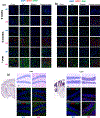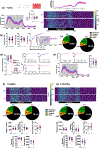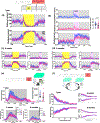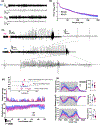Clinicopathologic Dissociation: Robust Lafora Body Accumulation in Malin KO Mice Without Observable Changes in Home-Cage Behavior
- PMID: 39039998
- PMCID: PMC11370821
- DOI: 10.1002/cne.25660
Clinicopathologic Dissociation: Robust Lafora Body Accumulation in Malin KO Mice Without Observable Changes in Home-Cage Behavior
Abstract
Lafora disease (LD) is a syndrome of progressive myoclonic epilepsy and cumulative neurocognitive deterioration caused by recessively inherited genetic lesions of EPM2A (laforin) or NHLRC1 (malin). Neuropsychiatric symptomatology in LD is thought to be directly downstream of neuronal and astrocytic polyglucosan aggregates, termed Lafora bodies (LBs), which faithfully accumulate in an age-dependent manner in all mouse models of LD. In this study, we applied home-cage monitoring to examine the extent of neurobehavioral deterioration in a model of malin-deficient LD as a means to identify robust preclinical endpoints that may guide the selection of novel genetic treatments. At 6 weeks, ∼6-7 months, and ∼12 months of age, malin-deficient mice ("KO") and wild-type (WT) littermates underwent a standardized home-cage behavioral assessment designed to non-obtrusively appraise features of rest/arousal, consumptive behaviors, risk aversion, and voluntary wheel-running. At all timepoints, and over a range of metrics that we report transparently, WT and KO mice were essentially indistinguishable. In contrast, within WT mice compared across the same timepoints, we identified age-related nocturnal hypoactivity, diminished sucrose preference, and reduced wheel-running. Neuropathological examinations in subsets of the same mice revealed expected age-dependent LB accumulation, gliosis, and microglial activation in cortical and subcortical brain regions. At 12 months of age, despite the burden of neocortical LBs, we did not identify spontaneous seizures during an electroencephalographic (EEG) survey, and KO and WT mice exhibited similar spectral EEG features. However, in an in vitro assay of neocortical function, paroxysmal bursts of network activity (UP states) in KO slices were more prolonged at 3 and 6 months of age, but similar to WT at 12 months. KO mice displayed a distinct response to pentylenetetrazole, with a greater incidence of clonic seizures and a more pronounced postictal suppression of movement, feeding, and drinking behavior. Together, these results highlight the clinicopathologic dissociation in a mouse model of LD, where the accrual of LBs may latently modify cortical circuit function and seizure threshold without clinically meaningful changes in home-cage behavior. Our findings allude to a delay between LB accumulation and neurobehavioral decline in LD: one that may provide a window for treatment, and whose precise duration may be difficult to ascertain within the typical lifespan of a laboratory mouse.
Keywords: Lafora body disease; astrogliosis; glycogen storage; home‐cage behavior; malin; polyglucosan.
© 2024 Wiley Periodicals LLC.
Conflict of interest statement
Figures







Update of
-
Clinicopathologic Dissociation: Robust Lafora Body Accumulation in Malin KO Mice Without Observable Changes in Home-cage Behavior.bioRxiv [Preprint]. 2023 Sep 13:2023.09.11.557226. doi: 10.1101/2023.09.11.557226. bioRxiv. 2023. Update in: J Comp Neurol. 2024 Jul;532(7):e25660. doi: 10.1002/cne.25660. PMID: 37745312 Free PMC article. Updated. Preprint.
References
Publication types
MeSH terms
Substances
Grants and funding
- U54HD104461/NH/NIH HHS/United States
- P01 NS097197/NS/NINDS NIH HHS/United States
- R37NS114516/NH/NIH HHS/United States
- R37 NS114516/NS/NINDS NIH HHS/United States
- S10 OD021684/OD/NIH HHS/United States
- R01 NS131399/NS/NINDS NIH HHS/United States
- P30 CA142543/CA/NCI NIH HHS/United States
- 1S10 OD021684-01/NH/NIH HHS/United States
- P01NS097197/NH/NIH HHS/United States
- K08NS110924/NH/NIH HHS/United States
- R01NS131399/NH/NIH HHS/United States
- U54 HD104461/HD/NICHD NIH HHS/United States
- K08 NS110924/NS/NINDS NIH HHS/United States
- 1P30 CA142543-01/NH/NIH HHS/United States
LinkOut - more resources
Full Text Sources
Research Materials

